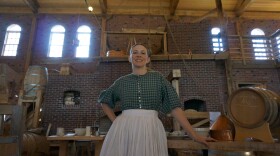This month marks the 100-year anniversary of the Miami Conservancy District, the flood protection system that was installed up and down the Great Miami River basin after the infamous Great Dayton Flood of 1913.
Listener Ellen Duell asked WYSO Curious a timely question:
“I wanted to know if the dams are still being protected, and how the conservancy district is operating to keep us from more great floods,” Duell said.
Duell is 86 and lives in Yellow Springs, but she raised her kids in an old house in Dayton View.

“Our family loved the Miami Conservancy areas and went picnicking at just about every one,” she recalls.
“At the time, it was amazing”
A quick history: The Miami Conservancy District or MCD was established in 1915 as a reaction to the flood and is an independent governmental body to design a flood control system for the region. Creating the district was a massive collaboration that involved passage of a state law allowing for this special kind of area for water management.
“At the time it was amazing, that’s probably the best word I can use,” says Kurt Rinehart, the chief engineer at MCD.
We meet at Taylorsville Dam, which looks like a long grassy hill—where the river is, there’s a cement wall with water flowing through a few doors at the base. Instead of using mechanical parts that open and close, the dam just backs up water into a nature area when it rains. There are five of these dams in the system, and these combined with miles levees further downstream keep the rivers from overflowing into cities and towns.

This whole system was conceived by Arthur Morgan and constructed from 1918-1922. The watershed-wide design, with no moving parts, was a very unusual concept.
“Nobody had ever proposed such a thing before,” says Rinehart. “A lot of people thought the guy was nuts, said what are you doing, that’s not how it works!”
In need of repair
What Ellen Duell wanted to know is how the conservancy district is doing these days.
“As you can see, the concrete is showing its age,” says Rinehart, looking out at the dam. It’s crumbling and chipped in some places, but he says for the most part, regular maintenance is keeping it all in check. There have also been major improvements in technology that allow better monitoring for safety, and higher-quality upgrades to cement surfaces originally created in nearly 100 years back. “It is manmade infrastructure, it takes a lot of upkeep and reinforcement and upgrades as necessary.”

Ellen was also curious how the whole thing gets paid for, which is fairly simple, too: everyone who owns property in the would-be floodplain is assessed a yearly fee—a charge for the flooding they would’ve had, but don’t. For special projects, the district has the authority to ask for capital fund levees; the last one raised $25 million, $20 million of which has already been spent on major dam and levee upgrades.
“Sometimes somebody will get their tax bill and they’ll call up and say, what in the world is this, what am I paying you for?” says Rinehart. Once they explain, he says people usually agree it’s a fair price to pay for the relative value of homes that would have been flooded many times.
A safe haven in the flood
Imagine this big rain in Dayton, in 1913: hundreds of people died. Hundreds of houses were underwater. Our question-asker Ellen Duell’s old house had actually just been built, and the owners were lucky.
“It was too high for the great floods to inundate it,” she says, but the house was surrounded by devastation. The young couple who bought it had planned to marry that spring, and instead of cancel the wedding, “they decided they would go right ahead, get married, and then invite people who lived in the lower areas, whose homes had been flooded out, to come and stay.”
The house became a safe haven. But now the whole city is safe from that kind of flooding: almost any conceivable amount of rain won’t overwhelm the levees and dams. Even with increasingly strong rains predicted because of climate change, Rinehart says, “we still have among the highest levels of flood protection anywhere in the world. Very few places have what we have.”
The Miami Conservancy District celebrates its one hundred year anniversary with an event at Carillon Historical Park Wednesday, June 24.
WYSO Curious is our series driven by your questions and curiosities about the Miami Valley. Is there something you’ve always wondered about the Miami Valley’s history, people, culture, economy, politics or environment? Send in a question now, and check back to see which questions we’re considering. WYSO Curious is a partner of WBEZ's Curious City, which was founded by Jennifer Brandel and is one of ten Localore productions brought to life by AIR.
_







